Geospatial Analysis and Land Suitability for “FloodWise” Practices: Nature-Based Solutions for Flood Mitigation in Eastern, Rural North Carolina
Abstract
:1. Introduction
1.1. Prior Geospatial Research
1.2. Research Context and Region
2. Methods
2.1. County Screening in Eastern North Carolina
2.2. Geospatial Criteria and Mapping for FloodWise Practices in Robeson County, NC
2.2.1. Eligible Cropland
2.2.2. Forest and Tree Planting (Afforestation)
2.2.3. Wetland Restoration and Creation
2.2.4. Dry Dams and Berms
2.2.5. Stream Restoration
3. Results
3.1. County Inventory Mapping
3.2. Eligible Cropland Identification
3.3. Forest and Tree Planting Opportunities
3.4. Wetland Restoration and Creation Opportunities
3.5. Water Farming Opportunities
3.6. Stream Restoration Opportunities
3.7. Overall FloodWise NBS Opportunities
4. Discussion
5. Conclusions
Author Contributions
Funding
Data Availability Statement
Conflicts of Interest
Appendix A. Various Geospatial Datasets Used in Land Suitability for FloodWise Practices
| Dataset | Description of Use | Resources | Resolution (meter)/Vector Dataset |
| Statewide 20-foot Digital Elevation Model (NC One Map) | The Statewide Digital Elevation Model (DEM) was used to calculate slope, a critical factor in determining site suitability for the FloodWise practices. | North Carolina Floodplain Mapping Program and North Carolina Department of Transportation. Digital Elevation Model (20’ Grid Cells). Raleigh, NC: NC One Map, 2017. Available online at: https://www.nconemap.gov (accessed on 2 September 2022) | 6-m |
| gSSURGO Gridded Soil Survey Geographic Database (USDA) | Attributes associated with the USDA soil survey database were used to identify hydric soils and low-productivity cropland. | Soil Survey Staff. (2008). Gridded Soil Survey Geographic (gSSURGO) Database for North Carolina. United States Department of Agriculture, Natural Resources Conservation Service. Available online at: https://www.nrcs.usda.gov/wps/portal/nrcs/detail/soils/survey/geo/?cid=nrcs142p2_053628 (accessed on 2 September 2022) | 30-m |
| Parcels (NC One Map) | Robeson County parcel boundaries with associated tax record attributes were used to incorporate property ownership information in the NBS suitability assessment. | NC One Map. North Carolina Parcels. Raleigh, NC: NC One Map, 2016. Available online at: https://www.nconemap.gov (accessed on 2 September 2022) | Vector dataset. 5-m resolution when converted to raster for analysis |
| Structures (NCEM and NC Flood Mapping Program) | This dataset containing all building footprints in North Carolina was analyzed to minimize any potential conflicts between the proposed FloodWise practices and existing infrastructure. | North Carolina Floodplain Mapping Program. North Carolina Building Footprints. Raleigh, NC: North Carolina Emergency Management, 2019. Available online at: https://www.nconemap.gov (accessed on 2 September 2022) | Vector dataset. 5-m resolution when converted to raster for analysis |
| Roads (NCDOT): | Location of roads was also analyzed to minimize any potential infrastructure conflicts. | North Carolina Department of Transportation (NC DOT). North Carolina Route Arcs. Raleigh, NC: NCDOT, 2021. Available online at: https://connect.ncdot.gov/resources/gis/ (accessed on 2 September 2022) | Vector dataset. 5-m resolution when converted to raster for analysis |
| National Landcover Database (Multi-Resolution Land Characteristics Consortium) | Identification of cropland and open land was based on the land cover classes included in this 2019 remotely sensed dataset. | Multi-Resolution Land Characteristics Consortium (MRLC). National Land Cover Database (NLDC). Available online at: https://www.mrlc.gov/data (accessed on 2 September 2022) | 30-m |
| Floodplain (FEMA) | Depending on the proposed nature-based solution, location within the FEMA 100-year and 500-year floodplains could either limit or enhance suitability. | Federal Emergency Management Agency (FEMA). (2020). FIMA NFIP Redacted Claims—V1. Washington DC, FEMA, 2020. Available online at: https://www.fema.gov/openfema-data-page/fima-nfip-redacted-claims-v1 (accessed on 2 September 2022) Federal Emergency Management Agency (FEMA). National Flood Hazard Layer. Washington DC, FEMA, 2021. Available online at: Available online at: https://www.fema.gov/flood-maps/national-flood-hazard-layer (accessed on 2 September 2022) | Vector dataset. 5-m resolution when converted to raster for analysis |
| HUC-12 Sub-watersheds (NC One Map) | For each proposed FloodWise practice, opportunity area results were summarized within each HUC-12 sub-watershed | North Carolina Department of Environmental Quality. 12-Digit HUC Watersheds.Derived from The United States Watershed Boundary Dataset, United States Geological Survey. Raleigh, NC: NCDEQ, 2013. Available online at: https://data-ncdenr.opendata.arcgis.com/datasets/12-digit-huc-subwatersheds/explore (accessed on 2 September 2022) | Vector dataset. |
| National Hydrography Dataset (USGS) | This dataset includes streamline geometry and classifications. | United States Geological Survey. National Hydrography Dataset. 2019. Available online at: https://www.usgs.gov/national-hydrography/national-hydrography-dataset (accessed on 2 September 2022) | Vector dataset |
| Crop Production (NASS) | The National Agricultural Statistics Survey (NASS) publishes a yearly dataset that refines the landcover classifications from the National Landcover Database to include spatial details about the types of crops grown. This dataset was used to identify high-value crops. | United States Department of Agriculture (USDA). Cropland Data Layer. Washington DC, National Agricultural Statistics Survey 2016–2020. Available online at: https://nassgeodata.gmu.edu/CropScape/ (accessed on 14 June 2022). | 30-m |
| Inundated Cropland (NASS) | NASS also publishes remotely sensed data delineated floodwater inundation on cropland from high-impact hurricanes. For Robeson County, cropland inundation data was available from Hurricanes Florence, Michael, and Dorian. | United States Department of Agriculture (USDA). Cropland Data Layer. Washington DC, National Agricultural Statistics Survey 2016–2020. Available online at: https://nassgeodata.gmu.edu/CropScape/ (accessed on 14 June 2022). National Agricultural Statistics Service (NASS). (2017). County Profile: Robeson County, North Carolina. 2017 Census of Agriculture. Available online: https://www.nass.usda.gov/Publications/AgCensus/2017/Online_Resources/County_Profiles/North_Carolina/cp37155.pdf (accessed on 2 September 2022) United States Department of Agriculture. Disaster Analysis Data. Washington DC, National Agricultural Statistics Survey, 2019. Available online at: https://www.nass.usda.gov/Research_and_Science/Disaster-Analysis/2019/index.php (accessed on 2 September 2022) | 30-m |
| Solar Panels (US Energy Information Administration) | This point dataset describing locations of solar energy plants is derived from a larger dataset identifying locations of all energy generating infrastructure in the United States. Solar farming is common in the North Carolina Coastal Plain and may represent a land use incompatible with FloodWise practices. | United States Energy Information Administration. Power Plants. Washington DC, 2020. Available online at: https://www.eia.gov/opendata/ (accessed on 2 September 2022) | V dataset |
| Communications Towers (Department of Homeland Security Homeland Infrastructure Data) | Locations of communication towers were included in mapping activities to ensure any proposed floodwater storage strategies would not interfere with access to infrastructure. | Department of Homeland Security. Cellular Towers. Washington DC, Homeland Infrastructure Foundation-Level Data, 2021. Available online at: https://hifld-geoplatform.opendata.arcgis.com/ (accessed on 2 September 2022) | Vector dataset |
References
- International Panel on Climate Change (IPCC). AR6 Climate Change 2021: The Physical Science Basis. 2021. Available online: https://www.ipcc.ch/report/ar6/wg1/#SPM (accessed on 22 January 2022).
- Scholz, M.; Yang, Q. Guidance on variables characterizing water bodies including sustainable flood retention basins. Landsc. Urban Plan. 2010, 98, 190–199. [Google Scholar] [CrossRef]
- U.S. Environmental Protection Agency (EPA). Climate Change Indicators in the United States, 4th ed.; United States Environmental Protection Agency: Washington, DC, USA, 2016.
- Biesecker, M. Hurricane Florence Could Cost Carolina Farms Billions in Damage. PBS News. 21 September 2018. Available online: https://www.pbs.org/newshour/economy/hurricane-florence-could-cost-carolina-farms-billions-in-damage (accessed on 15 August 2021).
- Center for Disease Control and Prevention (CDC). Public Health Consequences of a Flood Disaster. MMWR Weekly, 3 September 1993. Available online: https://www.cdc.gov/mmwr/preview/mmwrhtml/00021451.htm (accessed on 27 July 2022).
- Collentine, D.; Futter, M.N. Realizing the potential of natural water measures in catchment flood management: Trade-offs and matching interests. J. Flood Risk Manag. 2018, 11, 76–84. [Google Scholar] [CrossRef]
- Dadson, S.J.; Hall, J.W.; Murgatroyd, A.; Acreman, M.; Bates, P.; Beven, K.; Wilby, R. A restatement of the natural science evidence concerning catchment-based ‘natural’ flood management in the U.K. Proc. R. Soc. Math. Phys. Eng. Sci. 2017, 473, 20160706. [Google Scholar]
- Jha, A.K.; Bloch, R.; Lamond, J. Cities and Flooding: A Guide to Integrated Urban Flood Risk Management for the 21st Century; World Bank Publications: Washington, DC, USA, 2012. [Google Scholar]
- International Union for Conservation of Nature (IUCN). WCC-2016-Res-069-EN: Defining Nature-based Solutions. 2016. Available online: https://portals.iucn.org/library/sites/library/files/resrecfiles/WCC_2016_RES_069_EN.pdf (accessed on 27 April 2022).
- Nicholson, A.; O’Donnell, G.; Wilkinson, M. The potential of runoff attenuation features as a Natural Flood Management Approach. J. Flood Risk Manag. 2019, 13, e12565. [Google Scholar] [CrossRef]
- Aly, N.A.; Casillas, G.; Luo, Y.S.; McDonald, T.J.; Wade, T.L.; Zhu, R.; Newman, G.; Lloyd, D.; Wright, F.A.; Chiu, W.A. Environmental impacts of Hurricane Florence flooding in eastern North Carolina: Temporal analysis of contaminant distribution and potential human health risks. J. Expo. Sci. Environ. Epidemiol. 2021, 31, 810–822. [Google Scholar] [CrossRef] [PubMed]
- Raymond, C.M.; Berry, P.; Breil, M.; Nita, M.R.; Kabisch, N.; de Bel, M.; Enzi, V.; Frantzeskaki, N.; Geneletti, D.; Cardinaletti, M.; et al. An Impact Evaluation Framework to Support Planning and Evaluation of Nature-Based Solutions Projects. Report Prepared by the EKLIPSE Expert Working Group on Nature-Based Solutions to Promote Climate Resilience in Urban Areas; Centre for Ecology & Hydrology: Wallingford, UK, 2017. [Google Scholar]
- South Florida Water Management District (SFWMD). Water Farming Pilot Projects Final Report: An Evaluation of Water Farming as a Means for Providing Water Storage/Retention and Improving Water Quality in the Indian River Lagoon/Saint Lucie River Watershed. 2018. Available online: https://www.sfwmd.gov/document/water-farming-pilot-projects-final-report-august-2018 (accessed on 2 September 2022).
- Prybutok, S.; Newman, G.; Atoba, K.; Sansom, G.; Tao, Z. Combining Costing Nature and Suitability Modeling to Identify High Flood Risk Areas in Need of Nature-Based Services. Land 2021, 10, 853. [Google Scholar] [CrossRef] [PubMed]
- Federal Emergency Management Agency (FEMA). Building Community Resilience with Nature-Based Solutions; U.S. Federal Emergency Management Agency: Washington, DC, USA, June 2021. Available online: https://www.fema.gov/sites/default/files/documents/fema_riskmap-nature-based-solutions-guide_2021.pdf (accessed on 17 June 2022).
- Nature-Based Solutions Coalition. The Nature-Based Solutions for Climate Manifesto—Developed for the UN Climate Action Summit 2019, Nature-Based Solutions, 14 August 2019. Available online: https://wedocs.unep.org/xmlui/bitstream/handle/20.500.11822/29705/190825NBSManifesto.pdf?sequence=1 (accessed on 17 June 2022).
- Chausson, A.; Turner, B.; Seddon, D.; Chabaneix, N.; Girardin, C.; Kapos, V.; Key, I.; Roe, D.; Smith, A.; Woroniecki, S.; et al. Mapping the effectiveness of Nature-based Solutions for climate change adaptation. Glob. Chang. Biol. 2021, 26, 6134–6155. [Google Scholar] [CrossRef] [PubMed]
- Solheim, A.; Capobianco, V.; Oen, A.; Kalsnes, B.; Wullf-Knutsen, T.; Olsen, M.; Del Seppia, N.; Arauzo, I.; Garcia Balaguer, E.; Strout, J.M. Implementing Nature-Based Solutions in Rural Landscapes: Barriers Experienced in the PHUSICOS Project. Sustainability 2021, 13, 1461. [Google Scholar] [CrossRef]
- Pristeri, G.; Peroni, F.; Pappalardo, S.E.; Codato, D.; Masi, A.; De Marchi, M. Whose Urban Green? Mapping and Classifying Public and Private Green Spaces in Padua for Spatial Planning Policies. ISPRS Int. J. Geo-Inf. 2021, 10, 538. [Google Scholar] [CrossRef]
- Pittman, S.J.; Stamoulis, K.A.; Antonopoulou, M.; Das, M.S.; Shahid, M.; Delevaux, J.M.S.; Wedding, L.M.; Mateos-Molina, D. Rapid Site Selection to Prioritize Coastal Seascapes for Nature-Based Solutions with Multiple Benefits. Front. Mar. Sci. 2022, 9, 832480. [Google Scholar] [CrossRef]
- Senes, G.; Ferrario, P.S.; Cirone, G.; Fumagalli, N.; Frattini, P.; Sacchi, G.; Valè, G. Nature-Based Solutions for StormWater Management—Creation of a Green Infrastructure Suitability Map as a Tool for Land-Use Planning at the Municipal Level in the Province of Monza-Brianza (Italy). Sustainability 2021, 13, 6124. [Google Scholar] [CrossRef]
- Dela Torre, D.M.; dela Cruz, P.K.; Jose, R.P.; Gatdula, N.B.; Blanco, A.C. Geospatial Assessment of Vulnerabilities of Croplands to Flooding Risks: A Case Study of Philippine River Basins. Int. Arch. Photogramm. Remote Sens. Spat. Inf. Sci. 2019, XLII-4/W19, 173–180. [Google Scholar] [CrossRef]
- Guerrero, P.; Haase, D.; Albert, C. Identifying Spatial Patterns and Ecosystem Service Delivery of Nature-Based Solutions. Environ. Manag. 2022, 69, 735–751. [Google Scholar] [CrossRef] [PubMed]
- Mubeen, A.; Ruangpan, L.; Vojinovic, Z.; Torrez, A.S.; Plavšić, J. Planning and Suitability Assessment of Large-scale Nature-based Solutions for Flood-risk Reduction. Water Resour. Manag. 2021, 35, 3063–3081. Available online: https://doi-org.prox.lib.ncsu.edu/10.1007/s11269-021-02848-w (accessed on 2 September 2022). [CrossRef]
- Jacobs, K.J. Costly and Deadly Hurricanes Made History in NC. Wcnc.com. 30 August 2021. Available online: https://www.wcnc.com/article/weather/costliest-and-deadliest-hurricanes-for-north-carolina/275-6618aa82-ef96-4289-94f4-3f2e22af9675 (accessed on 17 June 2022).
- Ready, N.C. Hurricanes. Available online: https://www.readync.gov/stay-informed/north-carolina-hazards/hurricanes#history (accessed on 17 June 2022).
- Hovis, M.; Cubbage, F.; Hollinger, J.C.; Shear, T.; Doll, B.; Kurki-Fox, J.; Line, D.; Lovejoy, M.; Evans, B.; Potter, T. Determining the costs, revenues, and cost-share payments for the “FloodWise” program: Nature-based solutions to mitigate flooding in eastern, rural North Carolina. Nat.-Based Solut. 2022, 2, 100016. [Google Scholar] [CrossRef]
- Hovis, M.; Hollinger, J.C.; Cubbage, F.; Shear, T.; Doll, B.; Kurki-Fox, J.J.; Line, D.; Fox, A.; Baldwin, M.; Klondike, T.; et al. Natural Infrastructure Practices as Potential Flood Storage and Reduction for Farms and Rural Communities in the North Carolina Coastal Plain. Sustainability 2021, 13, 9309. [Google Scholar] [CrossRef]
- Rains, C. Robeson County Working Lands Protection Plan. October 2019. Available online: https://umo.edu/wp-content/uploads/Robeson-County-Working-Lands-Protection-Plan.pdf (accessed on 14 June 2022).
- US Census Bureau. Quick Facts: Robeson County, North Carolina. 2021. Available online: https://www.census.gov/quickfacts/fact/table/robesoncountynorthcarolina/POP010220#POP010220 (accessed on 14 June 2022).
- North Carolina Rural Center. About Us. 2020. Available online: https://www.ncruralcenter.org/about-us/ (accessed on 14 June 2022).
- Strickland, C.; Disaster Relief for Farmers. NC Cooperative Extension. 2018. Available online: go.ncsu.edu/readext?562285 (accessed on 29 August 2022).
- North Carolina Geodetic Survey (NCGS). North Carolina Counties. Available online: https://ncgs.nc.gov/geodeticmonuments/ (accessed on 6 September 2022).
- National Agricultural Statistics Service (NASS). County Profile: Robeson County, North Carolina. 2017 Census of Agriculture. 2017. Available online: https://www.nass.usda.gov/Publications/AgCensus/2017/Online_Resources/County_Profiles/North_Carolina/cp37155.pdf (accessed on 14 June 2022).
- Brown, M.J. Forest Statistics for North Carolina, 2002; Resour. Bull. SRS-68; U.S. Department of Agriculture, Forest Service, Southern Research Statio: Asheville, NC, USA, 2004; 78p.
- Multi-Resolution Land Characteristics Consortium (MRLC). National Land Cover Database (NLCD) Class Legend and Description; Multi-Resolution Land Characteristics Consortium: Research Triangle Park, NC, USA, 2019. Available online: https://www.mrlc.gov/data (accessed on 14 June 2022).
- United States Department of Agriculture (USDA). Cropland Data Layer, National Agricultural Statistics Survey (NASS): Washington DC, USA, 2016–2020. Available online: https://nassgeodata.gmu.edu/CropScape/ (accessed on 14 June 2022).
- North Carolina Department of Transportation (NC DOT). North Carolina Route Arcs. NCDOT: Raleigh, NC, USA, 2021. Available online: https://connect.ncdot.gov/resources/gis/ (accessed on 14 June 2022).
- North Carolina Floodplain Mapping Program. North Carolina Building Footprints. North Carolina Emergency Management: Raleigh, NC, USA, 2019. Available online: https://www.nconemap.gov (accessed on 2 September 2022).
- United States Energy Information Administration. Power Plants. Washington DC, 2020. Available online: https://www.eia.gov/opendata/ (accessed on 14 June 2022).
- Department of Homeland Security. Cellular Towers; Homeland Infrastructure Foundation-Level Data: Washington, DC, USA, 2021; Available online: https://hifld-geoplatform.opendata.arcgis.com/ (accessed on 14 June 2022).
- Cubbage, F.; Glenn, V.; Mueller, J.P.; Robison, D.; Myers, R.; Luginbuhl, J.-M.; Myers, R. Early tree growth, crop yields and estimated returns for an agroforestry trial in Goldsboro, North Carolina. Agrofor. Syst. 2012, 86, 323–334. Available online: https://doi-org.prox.lib.ncsu.edu/10.1007/s10457-012-9481-0 (accessed on 2 September 2022). [CrossRef]
- Pattanayak, S.; Mercer, D.E.; Sills, E.; Yang, J.C. Taking stock of agroforestry adoption studies. Agrofor. Syst. 2003, 57, 173–186. [Google Scholar] [CrossRef]
- Soil Survey Staff. Gridded Soil Survey Geographic (gSSURGO) Database for North Carolina. United States Department of Agriculture, Natural Resources Conservation Service. 2008. Available online: https://gdg.sc.egov.usda.gov/ (accessed on 14 June 2022).
- Luu, T.A.; Nguyen, A.T.; Trinh, Q.A.; Pham, V.T.; Le, B.B.; Nguyen, D.T.; Hoang, Q.N.; Pham, H.T.T.; Nguyen, T.K.; Luu, V.N. Farmers’ Intention to Climate Change Adaptation in Agriculture in the Red River Delta Biosphere Reserve (Vietnam): A Combination of Structural Equation Modeling (SEM) and Protection Motivation Theory (PMT). Sustainability 2019, 11, 2993. [Google Scholar] [CrossRef] [Green Version]
- Rogers, R.W. Cognitive and physiological processes in fear appeals and attitude change: A revised theory of protection motivation. In Social Psychophysiology: A Sourcebook; Cacioppo, B.L., Petty, L.L., Eds.; The Guilford Press: Guilford, NC, USA; London, UK, 1983; pp. 153–176. [Google Scholar]
- Rogers, R.W.; Prentice-Dunn, S. Protection motivation theory. In Handbook of Health Behaviour Research I: Personal and Social Determinants; Gochman, D.S., Ed.; Plenum Press: New York, NY, USA, 1997; pp. 113–132. [Google Scholar]
- Soil Survey Staff. Soil Taxonomy: A Basic System of Soil Classification for Making and Interpreting Soil Surveys; USDA Natural Resources Conservation Service, U.S. Government Printing Office: Washington, DC, USA, 1999; p. 869.
- Bryce, S.; Atlas, E. Percent Agriculture on Hydric Soil. U.S. Environmental Protection Agency. 2015. Available online: https://enviroatlas.epa.gov/enviroatlas/DataFactSheets/pdf/ESN/Percentagricultureonhydricsoil.pdf (accessed on 14 June 2022).
- North Carolina Floodplain Mapping Program and North Carolina Department of Transportation. Digital Elevation Model (20’ Grid Cells); NC One Map: Raleigh, NC, USA, 2017. Available online: https://www.nconemap.gov (accessed on 14 June 2022).
- Stephens, K. Stream and Wetland Restoration Site Searches for NCDOT. In Proceedings of the ESRI User Conference, San Diego, CA, USA, 11–15 July 2022; Available online: https://proceedings.esri.com/library/userconf/proc02/pap0994/p0994.htm (accessed on 27 April 2022).


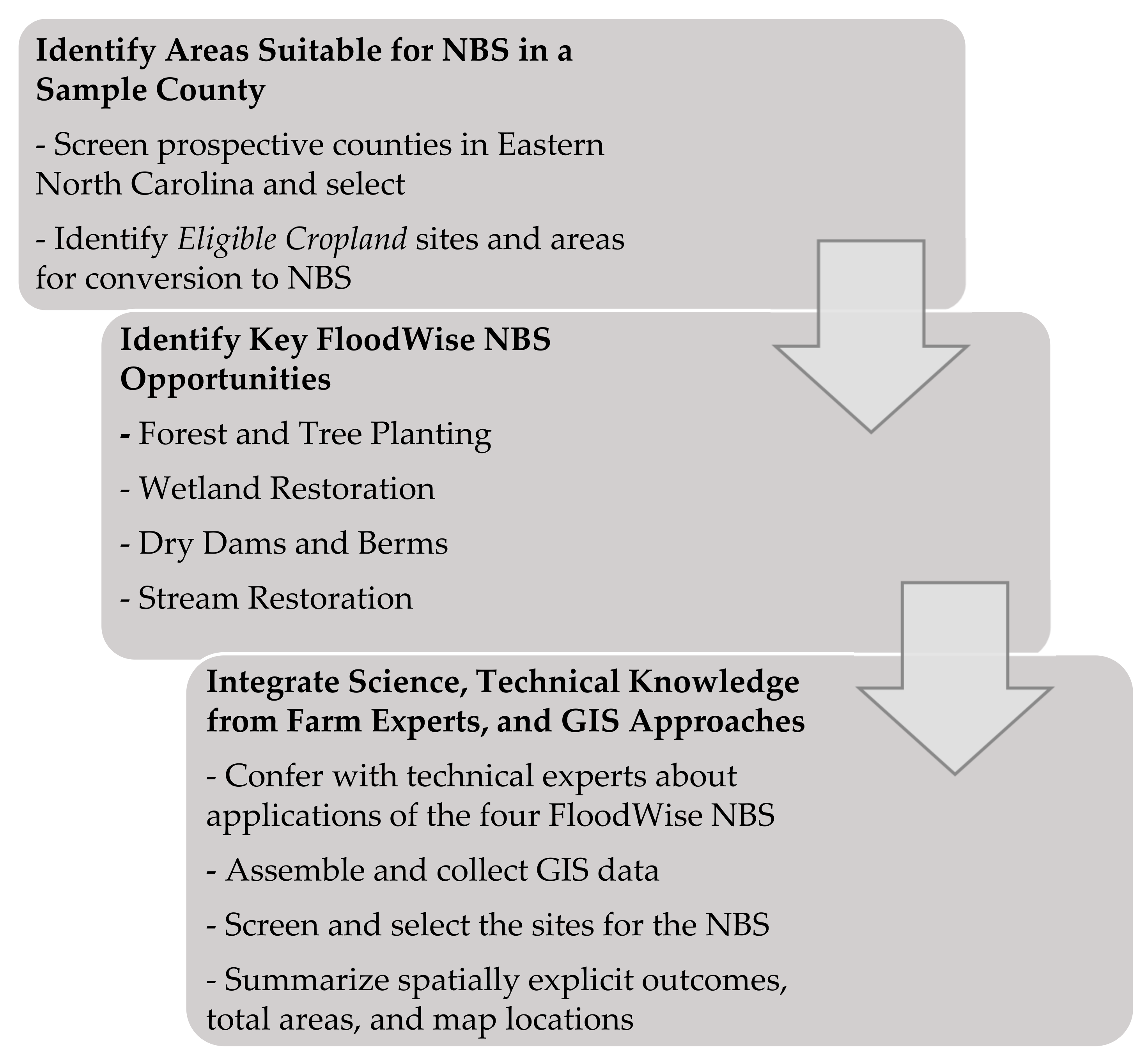
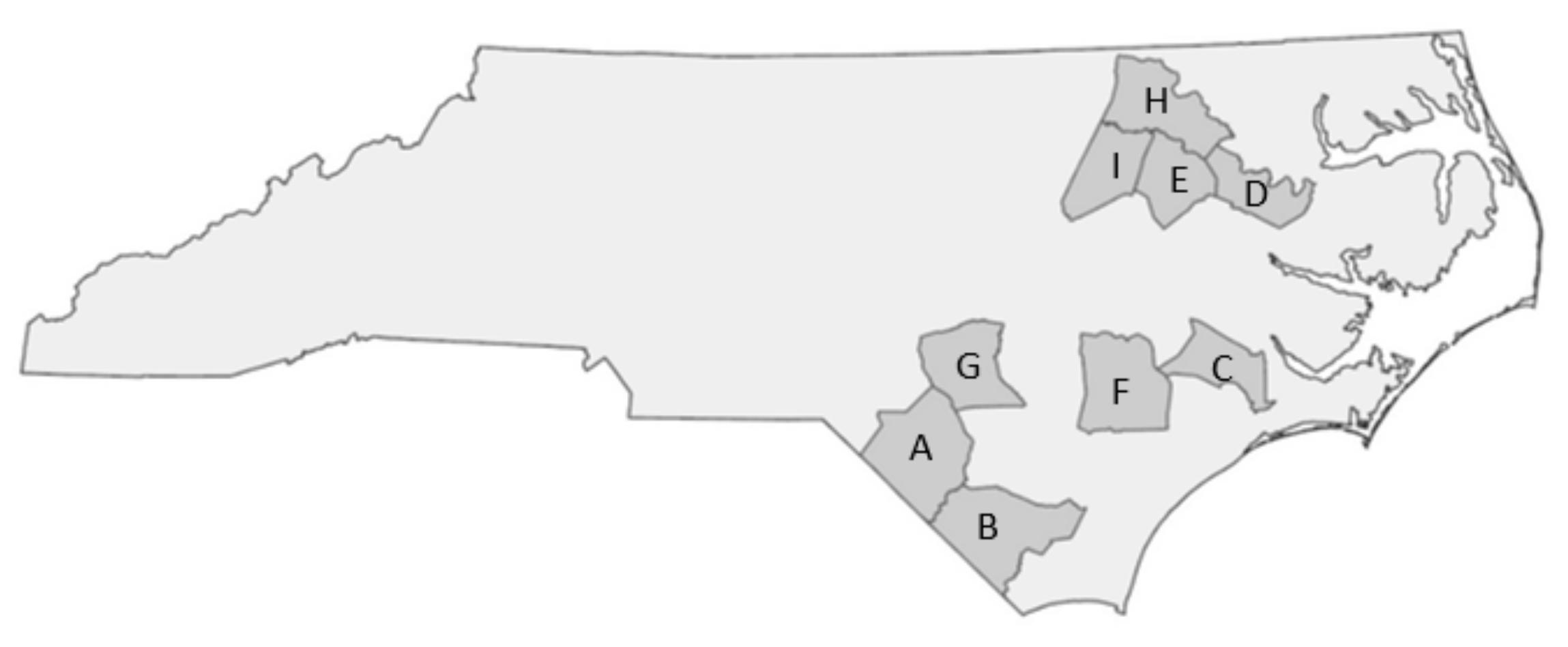
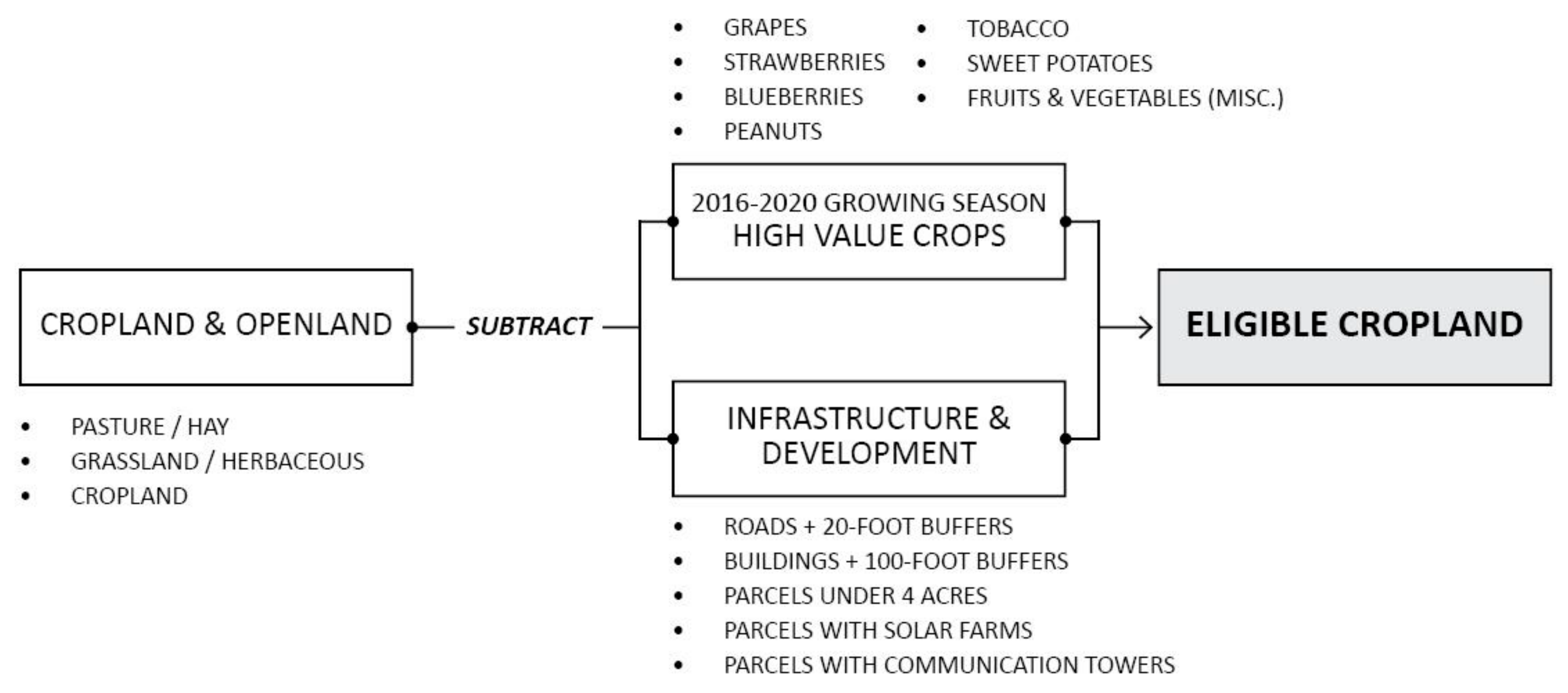

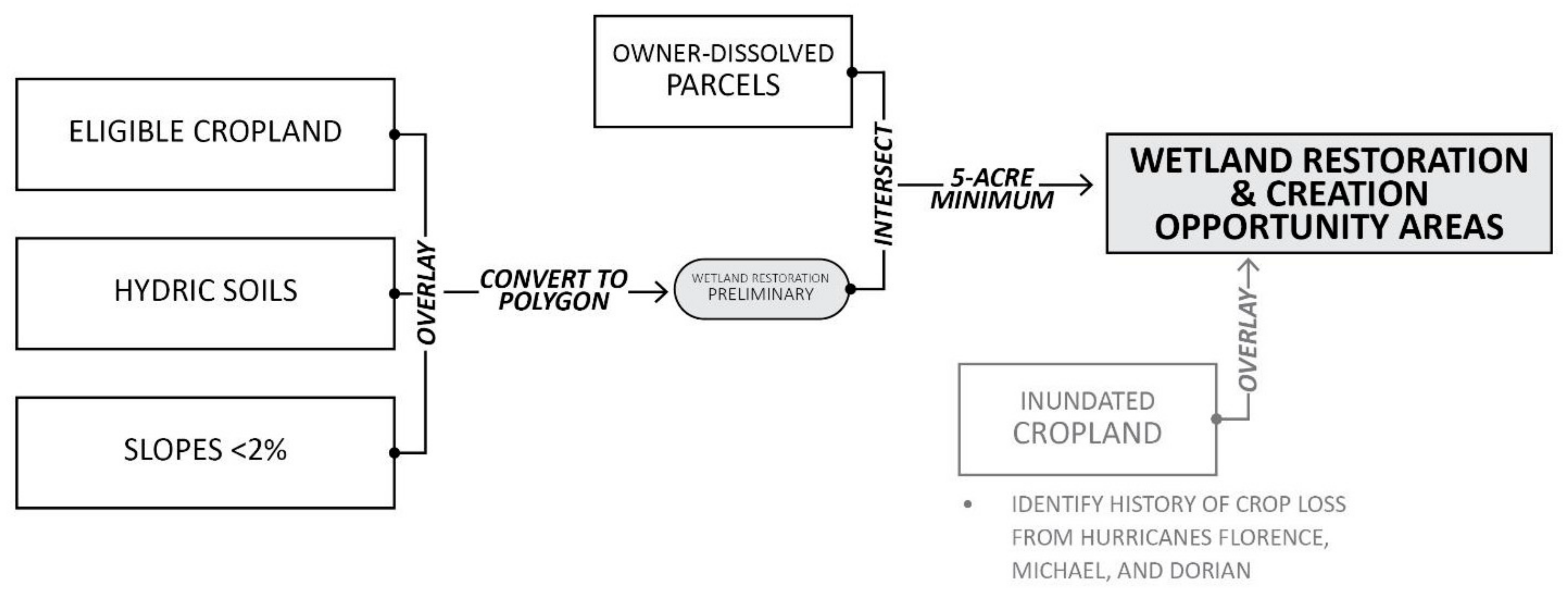


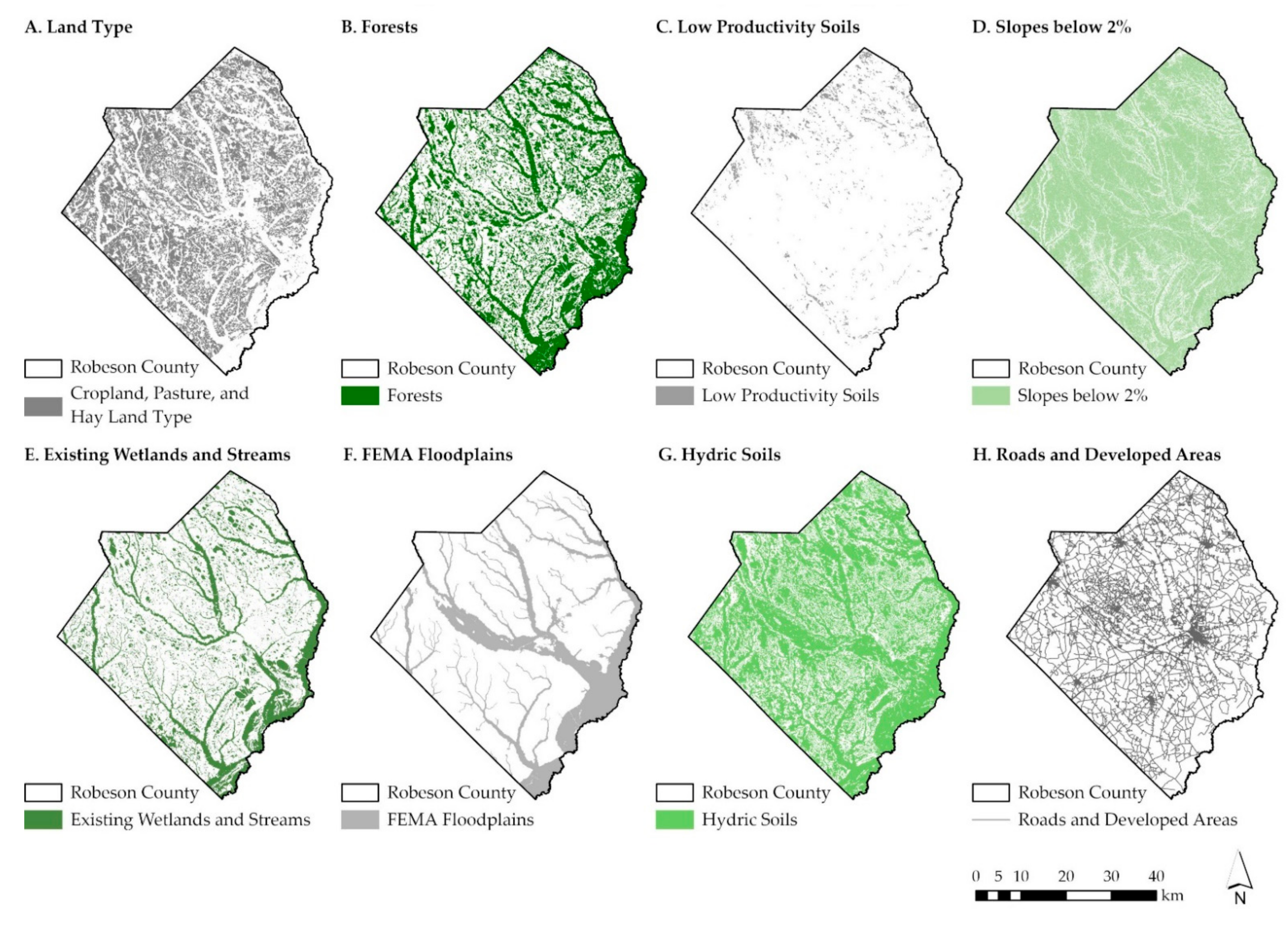
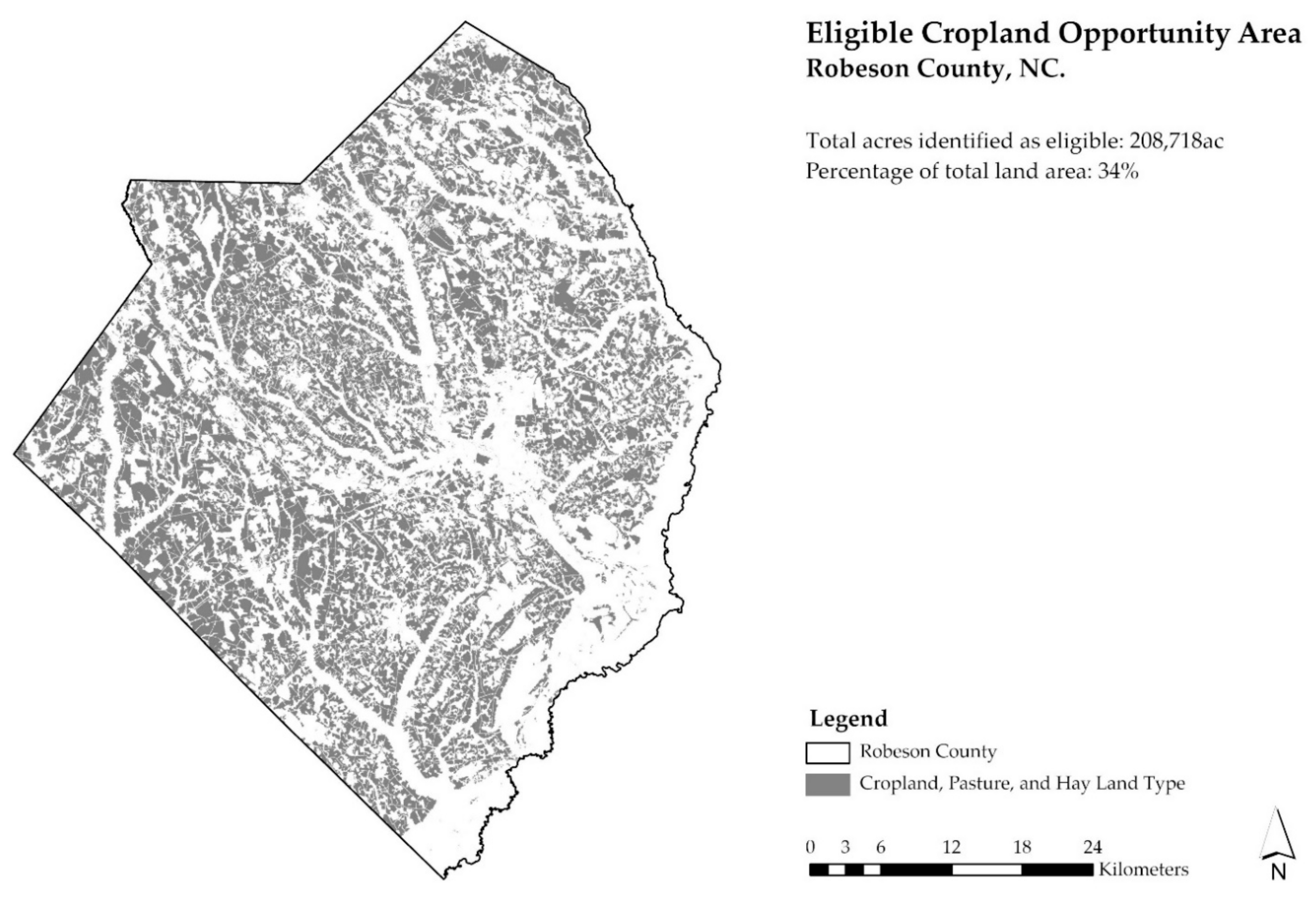
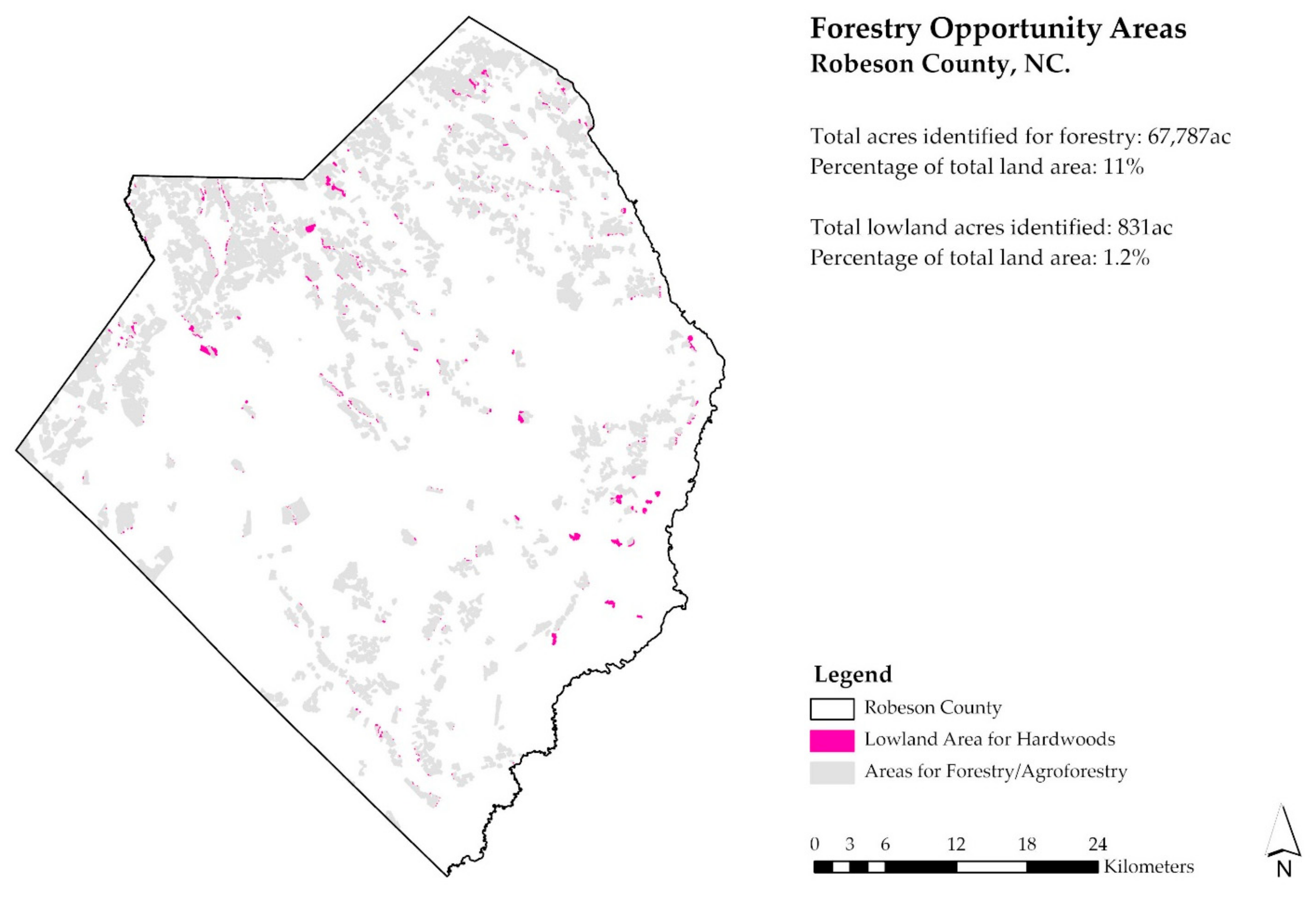



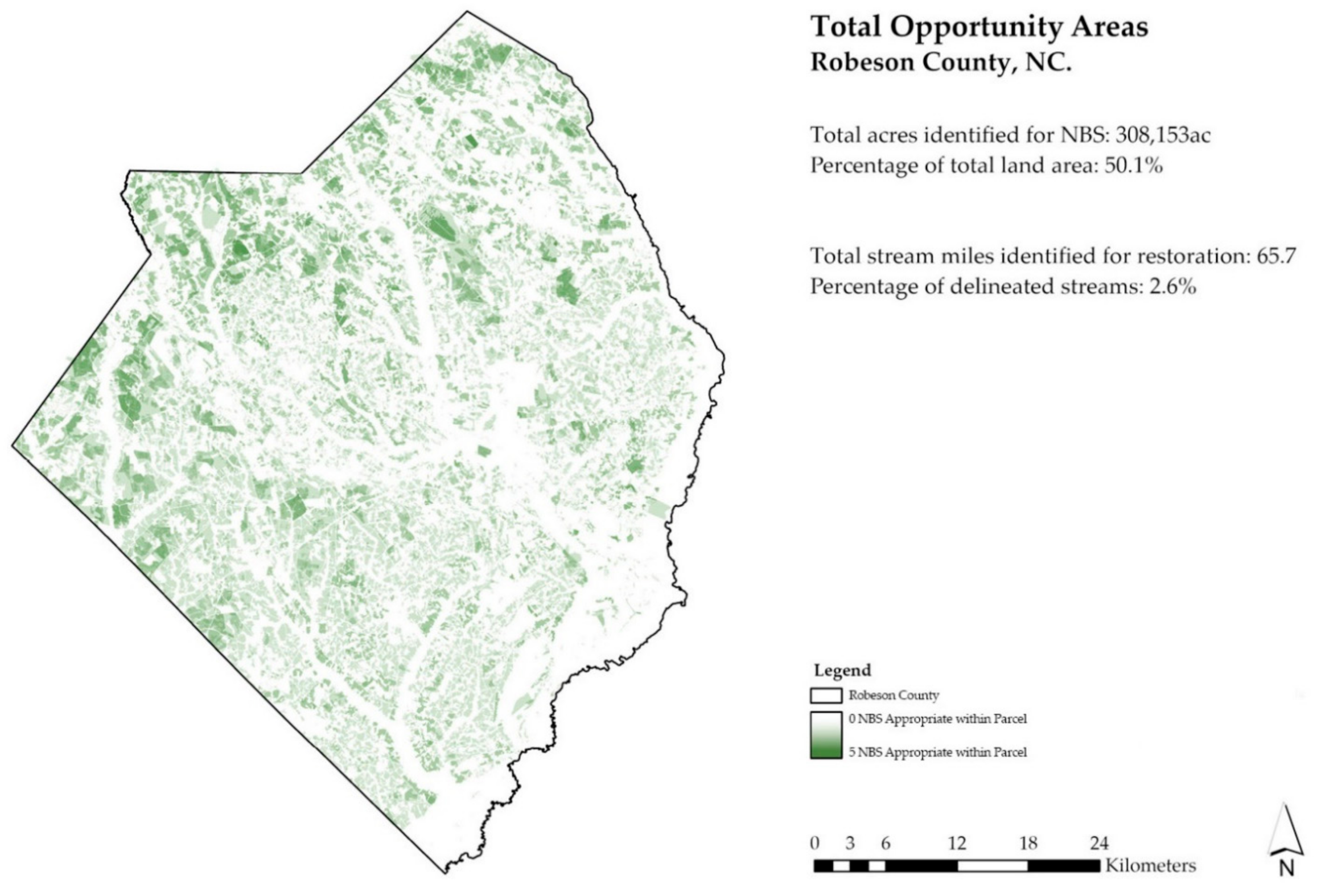
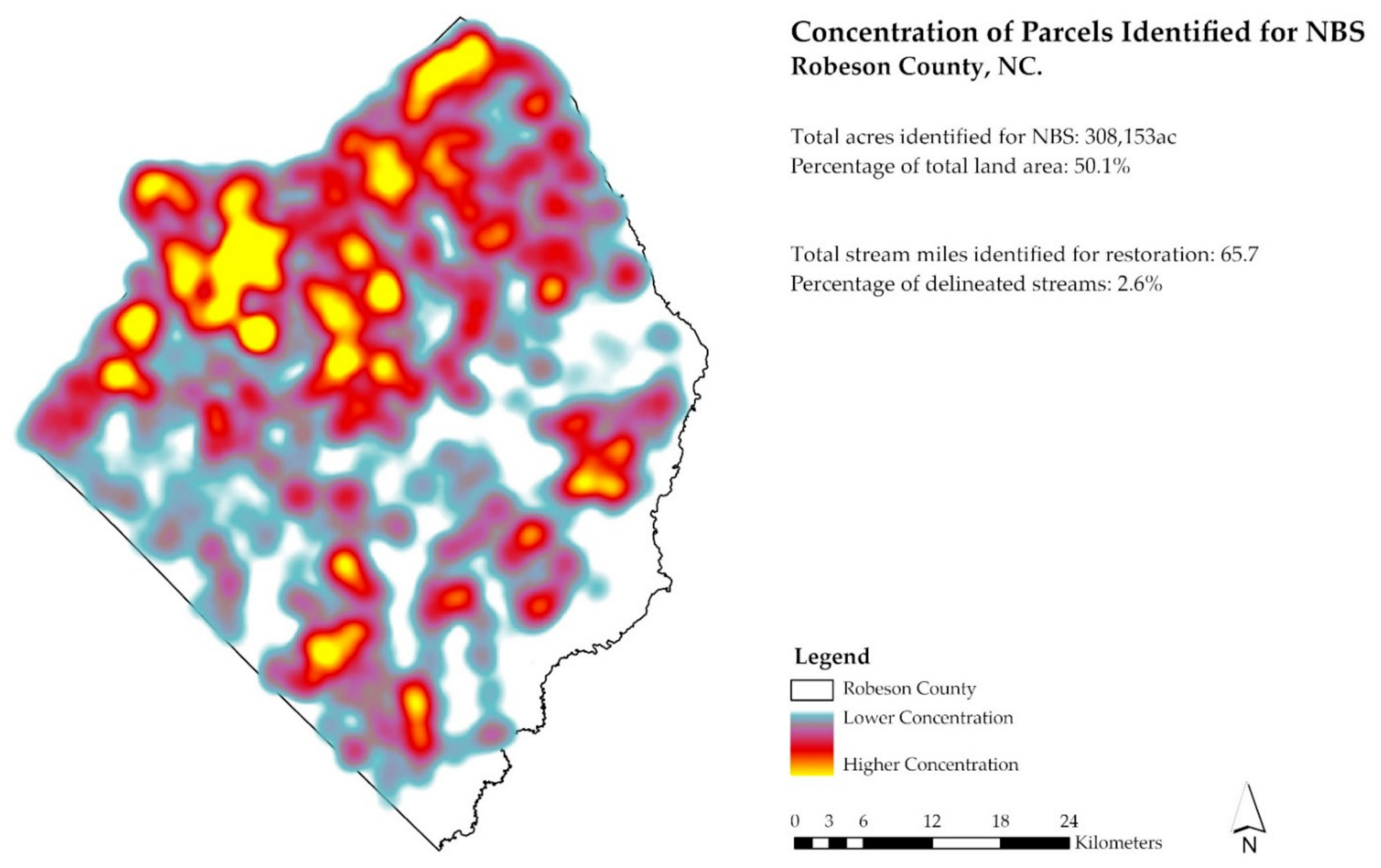
| Category | Description | General Geospatial Criteria |
|---|---|---|
| Agricultural | ||
| Agroforestry | Combining mixed pine trees and pasture fields | Cropland and open land (excluding high-value crops) with low-productivity soils. |
| Forests and Tree Planting (Afforestation) | Planting bottomland hardwood or pine forest species | Cropland and open land (excluding high-value crops) with low-productivity soils. |
| Hardpan Breakup | Breaking up compacted hardpan layers to allow for soil water infiltration | Not suitable for mapping; data unavailable Hardpan can occur naturally or result from farming practices. |
| Cover Crops and No-till | Including legume and non-legume cover crops on fields during winter | Not suitable for mapping. No explicit spatial criteria to determine site suitability. |
| Wetland and Stream | ||
| Wetland Restoration | Restoring natural wetlands along streams or at a lower elevation with the use of grasses, sedges, and water control structures, or bottomland hardwood wetland banks on prior converted agricultural land | Cropland and open land (excluding high-value crops) with hydric soils and slopes less than 2%. |
| Natural Stream Channel Restoration | Restoring previously straightened streams to the original configuration | Straightened stream segments (sinuosity < 1.04) no less than 1000 linear feet (304 m) with an unforested 200-foot (61 m) buffer |
| Structural | ||
| Dry Dams and Berms | Creating catchment areas to store water during flooding is also referred to as “water farming”. | Cropland and open land (excluding high-value crops) located outside the floodplain with slopes less than 2%. |
| Land Drainage Features | Installing land drainage ditch controls, such as tiles and tiling outlets | Not suitable for mapping. County-wide maps identifying locations of existing drainage systems were not available. |
| County | Area (ac) | Slopes Under 2% | Cropland | Low Slope Cropland | Low-Productivity Cropland | Inundated Cropland | Managed Timber Areas | ||||||
|---|---|---|---|---|---|---|---|---|---|---|---|---|---|
| ac | pct | ac | pct | ac | pct | ac | pct | ac | pct | ac | pct | ||
| Robeson (A) | 607,914 | 478,110 | 79% | 234,711 | 39% | 200,969 | 86% | 9975 | 4% | 14,363 | 6% | 18,922 | 3% |
| Columbus (B) | 611,415 | 461,663 | 76% | 149,502 | 24% | 110,500 | 74% | 2882 | 2% | 7226 | 5% | 76,129 | 12% |
| Jones (C) | 303,750 | 225,117 | 74% | 63,309 | 21% | 49,561 | 78% | 1276 | 2% | 8847 | 14% | 42,653 | 14% |
| Martin (D) | 292,954 | 212,460 | 73% | 90,556 | 31% | 69,789 | 77% | 638 | 1% | 2743 | 3% | 30,474 | 10% |
| Edgecombe (E) | 324,893 | 203,778 | 63% | 128,660 | 40% | 93,418 | 73% | 4743 | 4% | 11,300 | 9% | 19,547 | 6% |
| Duplin (F) | 525,540 | 322,105 | 61% | 190,272 | 36% | 126,671 | 67% | 3459 | 2% | 26,532 | 14% | 37,212 | 7% |
| Cumberland (G) | 421,071 | 236,696 | 56% | 74,746 | 18% | 58,723 | 79% | 11,267 | 15% | 8324 | 11% | 22,301 | 5% |
| Halifax (H) | 468,044 | 198,635 | 42% | 138,258 | 30% | 76,775 | 56% | 2927 | 2% | 9004 | 7% | 57,635 | 12% |
| Nash (I) | 347,761 | 110,729 | 32% | 110,295 | 32% | 42,357 | 38% | 967 | 1% | 136,740 | 12% | 30,180 | 9% |
| FloodWise NBS | Area (Total Acres) | Percentage of Total Area | Percentage of Eligible Cropland |
|---|---|---|---|
| Eligible Cropland | 208,718 acres | 34% | -- |
| Afforestation | 67,787 acres | 11% | 32% |
| Wetland Restoration | 27,716 acres | 4.50% | 13% |
| Dry Dams and Berms | 3932 acres | 0.60% | 1.80% |
| Stream Restoration (1000-foot minimum) | 65.7 stream miles | 2.6% (of total delineated streams) | -- |
| Stream Restoration (500-foot minimum) | 98.8 stream miles | 3.8% (of total delineated streams) | -- |
Publisher’s Note: MDPI stays neutral with regard to jurisdictional claims in published maps and institutional affiliations. |
© 2022 by the authors. Licensee MDPI, Basel, Switzerland. This article is an open access article distributed under the terms and conditions of the Creative Commons Attribution (CC BY) license (https://creativecommons.org/licenses/by/4.0/).
Share and Cite
Baldwin, M.; Fox, A.; Klondike, T.; Hovis, M.; Shear, T.; Joca, L.; Hester, M.; Cubbage, F. Geospatial Analysis and Land Suitability for “FloodWise” Practices: Nature-Based Solutions for Flood Mitigation in Eastern, Rural North Carolina. Land 2022, 11, 1504. https://doi.org/10.3390/land11091504
Baldwin M, Fox A, Klondike T, Hovis M, Shear T, Joca L, Hester M, Cubbage F. Geospatial Analysis and Land Suitability for “FloodWise” Practices: Nature-Based Solutions for Flood Mitigation in Eastern, Rural North Carolina. Land. 2022; 11(9):1504. https://doi.org/10.3390/land11091504
Chicago/Turabian StyleBaldwin, Madalyn, Andrew Fox, Travis Klondike, Meredith Hovis, Theodore Shear, Lauren Joca, Megan Hester, and Frederick Cubbage. 2022. "Geospatial Analysis and Land Suitability for “FloodWise” Practices: Nature-Based Solutions for Flood Mitigation in Eastern, Rural North Carolina" Land 11, no. 9: 1504. https://doi.org/10.3390/land11091504
APA StyleBaldwin, M., Fox, A., Klondike, T., Hovis, M., Shear, T., Joca, L., Hester, M., & Cubbage, F. (2022). Geospatial Analysis and Land Suitability for “FloodWise” Practices: Nature-Based Solutions for Flood Mitigation in Eastern, Rural North Carolina. Land, 11(9), 1504. https://doi.org/10.3390/land11091504








